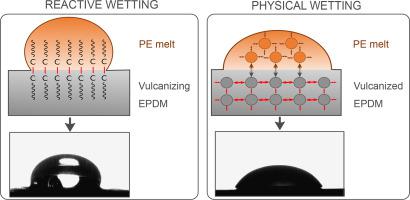Colloid and Interface Science Communications ( IF 4.7 ) Pub Date : 2020-12-06 , DOI: 10.1016/j.colcom.2020.100343 Brittany Laing , David Seveno , Jozefien De Keyzer , Albert Van Bael

|
If wetting is ubiquitous in nature, reactive wetting is up to now mostly described for metallic and ceramic systems. Characterizing wetting between two reactive organic polymers is more challenging due to their similar molecular structure and yet it is crucial to unravel adhesion mechanisms. This is for example the case when combining ethylene-propylene-diene terpolymer (EPDM) with polyolefins like polyethylene (PE). Therefore, in this study, a high temperature contact angle measurement methodology is presented to evidence the occurrence of chemical bonds at the interface. Spreading of PE was found to be restricted on vulcanizing peroxide-based EPDM, while on an already completely vulcanized EPDM, low static advancing contact angles were obtained. This restriction in wetting is ascribed to a co-vulcanization reaction between EPDM and PE. Furthermore, the chemical bonding mechanism is even more pronounced with higher peroxide concentrations in EPDM which also leads to a higher adhesion strength at the interface.
中文翻译:

聚乙烯在乙烯-丙烯-二烯三元共聚物上的反应润湿
如果润湿本质上是普遍存在的,那么到目前为止,对于金属和陶瓷体系而言,反应性润湿是最常见的。由于两种反应性有机聚合物的相似分子结构,表征它们之间的润湿性更具挑战性,但对于揭示粘附机理至关重要。例如,当将乙烯-丙烯-二烯三元共聚物(EPDM)与聚烯烃(如聚乙烯)混合时,就是这种情况。因此,在这项研究中,提出了一种高温接触角测量方法,以证明在界面处化学键的出现。发现PE的扩散受限于硫化基于过氧化物的EPDM,而在已经完全硫化的EPDM上,获得了低的静态前进接触角。润湿的这种限制归因于EPDM和PE之间的共硫化反应。











































 京公网安备 11010802027423号
京公网安备 11010802027423号